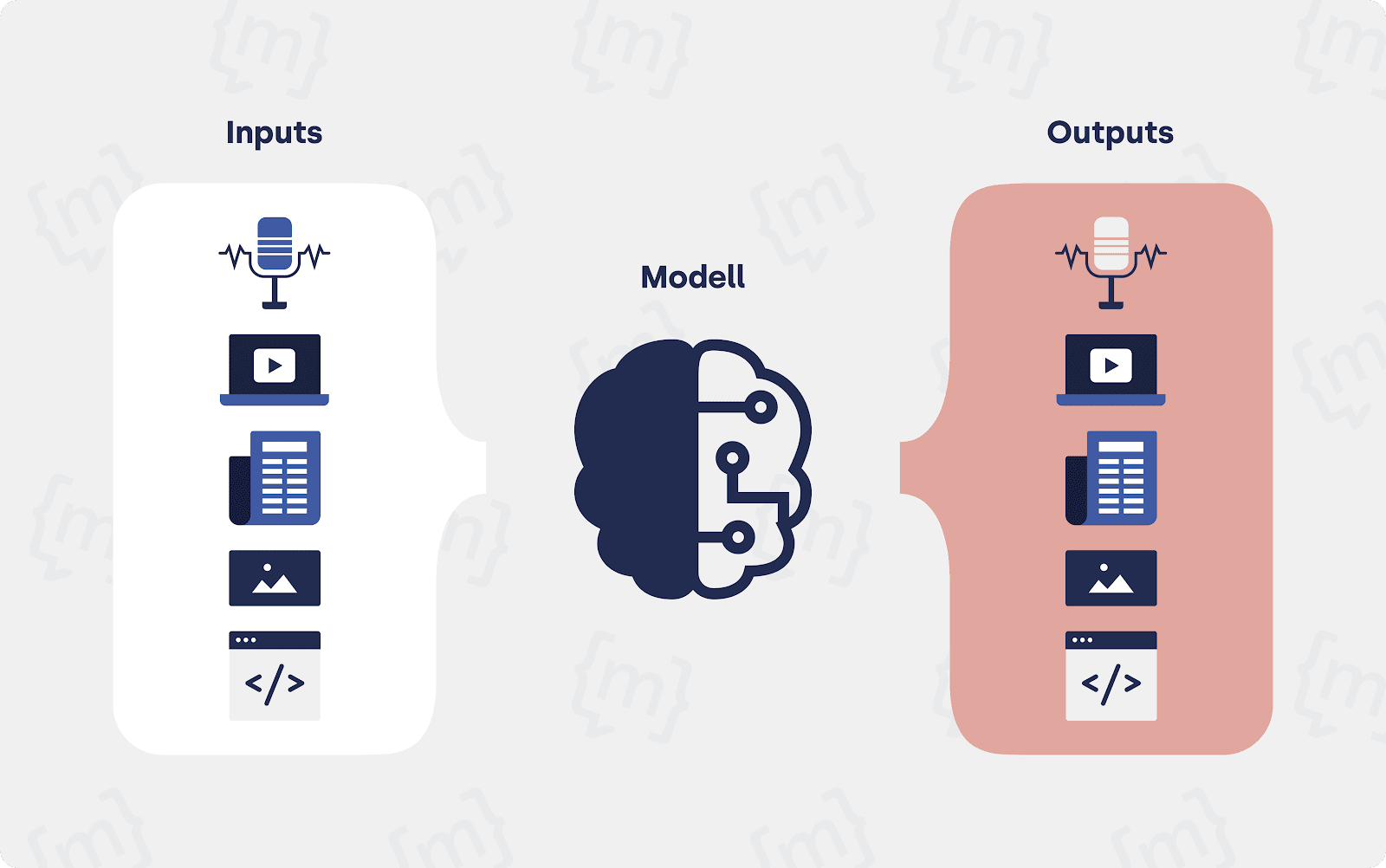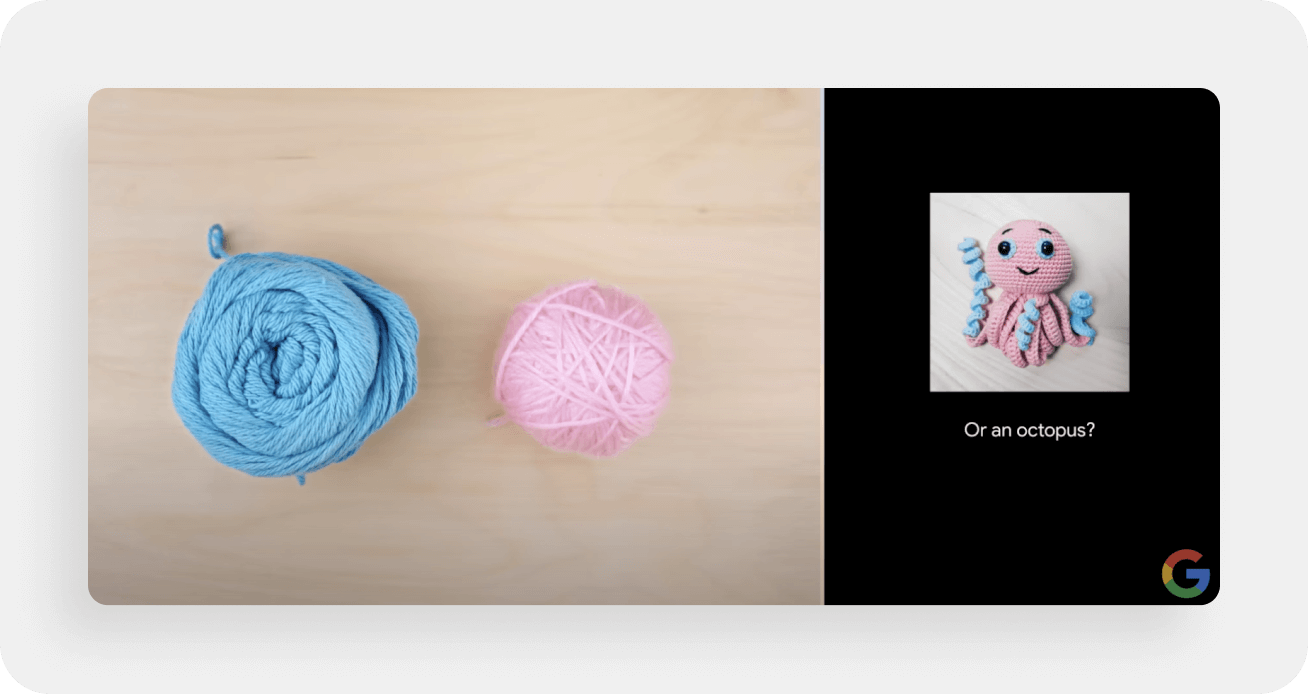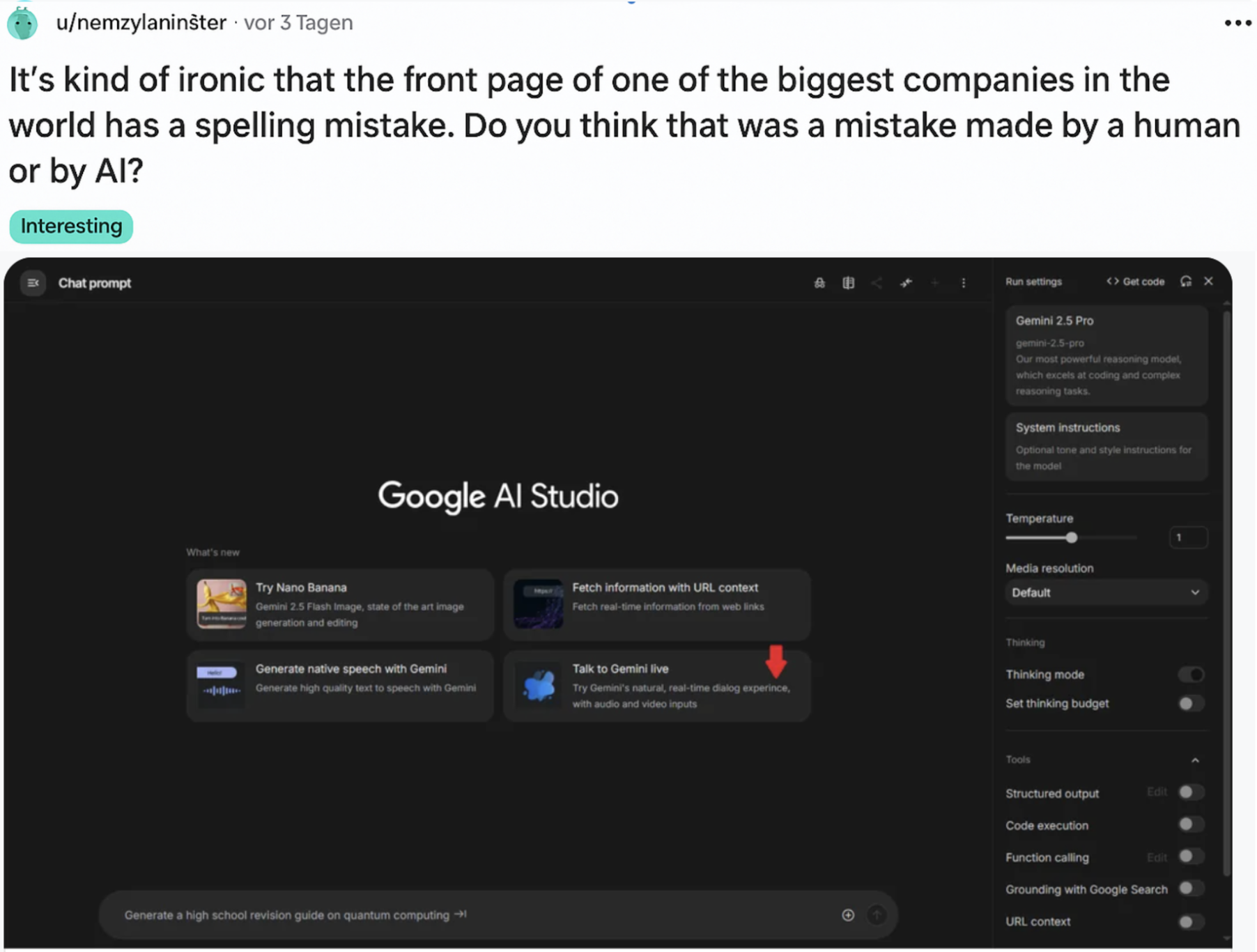Gemini 3: Overview of the November Release Updates
Before we explain Gemini as an AI application in more detail, we have briefly summarized the most important updates in the November 2025 release. Google CEO Sundar Pichai announced that Gemini 3 allows “any idea to come to life,” with a particular focus on multimodality, agentic coding, and visual and interactive outputs.
Everything you need to know at a glance:
What does this mean for users? For users and businesses, Gemini offers improved, multimodal AI support for text, images, layouts, planning, and scalable enterprise solutions. For developers, more control and flexibility are created through deep “thinking,” expanded media inputs, structured outputs, and more tool integrations than ever before. This means faster implementation for software projects, e.g., prototypes, using the Gemini app, developer tools, and the combination of Antigravity and Gemini 3.
What is behind Google Gemini?
Google Gemini comprises a family of multimodal large language models That are capable of understanding and generating text, images, videos, and programming code. This definition contains two terms that need to be explained in more detail in order to better understand Google Gemini.
In the field of artificial intelligence, Large language models (LLMs for short) primarily refer to neural networks that are capable of understanding, processing, and generating human language in various ways. The term “large” describes the fact that these models are trained on vast amounts of data and have several billion neurons or parameters that recognize the underlying structures in the text.
Multimodal models Are a subfield of machine learning and include architectures that can process multiple variants of data, known as modalities. Until now, most models could only process a single type of data, such as text or images. Multimodal models, on the other hand, are capable of accepting and processing different formats.

Similar to the competition, OpenAI and its models GPT-4 And GPT-5, Google Gemini too is multimodal, meaning it can process different types of input, such as text, images, or programming code, and also provide tailored output. Unlike GPT-5, Gemini is designed to be multimodal from the ground up, allowing text, images, audio, and video to be processed within a single model, while GPT-5 uses separate submodels for specific input types.
What makes Google Gemini 2.5 and the Gemini 3 updates for app use in 2025 so special Is not only their ability to process text, audio, video, images, and programming code, but also to use these multimodal inputs for complex conclusions. This makes it possible to tackle demanding tasks in areas such as mathematics or physics, as well as data-intensive analyses, much more efficiently. In Google's current demonstrations, Gemini can not only detect incorrect calculations, but also automatically generate the correct solution and explain the calculation process in an understandable way. In addition, the improved Deep Think and Multi-Expert Architecture allows for even more precise analysis and problem solving in multiple steps.
What is Google Gemini capable of?
Google Gemini was unveiled for the first time at a virtual press conference on December 6, 2023. At the same time, articles describing the functionalities of the new AI family were published on both the Google Blog and the website of the AI company Google DeepMind.
Initial functions
Early Versions enabled simple code generation, image processing, and the combination of text and image information, among other things. Gemini is frequently used for basic research and learning support. With the introduction of Gemini 2 and subsequent updates, these capabilities have been steadily improved, particularly through deep think modes for multi-step reasoning, processing longer documents, and analyzing complex mathematical and scientific tasks.
Interpretation and Generation
Gemini can now create programming code simply by analyzing an image of a finished application. For example, websites can be recreated using a screenshot of the current page. Although this capability was also available in GPT-4 and its predecessor Bard, Gemini 2.5 and the latest updates have significantly improved the accuracy and quality of the results. While a screenshot cannot capture the full complexity of a website or program, it serves as a good starting point for further programming.
The combination of images and text has also been improved. Users can provide two images as input, and Gemini generates a new image with a matching description. An example from Google shows how two different-colored balls of wool can be used to create a wool octopus, complete with instructions on how to make it.

Its Use in education Is particularly impressive. Gemini can't only check tasks, but also explain what mistakes were made and how they can be corrected. This ability to think and argue at multiple levels clearly demonstrates the progressiveness of AI.
Just a few days after the initial presentation, some users discovered the important information hidden in the video descriptions of YouTube videos. Google had tricked users in its presentation videos by using still images and text inputs when the model was supposed to recognize that the video showed a Game of Rock-Paper-Scissors. This approach was met with some criticism, as the presentation in their blog suggested significantly more capabilities than the model was actually able to perform.
With Gemini Live, users have been able to talk to the AI in real time without typing since September 2024, and Gemini responds verbally. In 2025, Gemini will be available live in over 45 languages, which will make communication across national borders much easier. In addition, Google AI Pro users can set Gemini to remember previous conversations. This makes the interaction even more personalized, but the protection of personal data must be taken into account.
The deep research function now runs in several versions via “thinking” mode, which enables the analysis of large amounts of data and the creation of multi-page reports in a short time. Since April 2025, users have been able to generate short videos via text input using Veo 2, which can be downloaded and shared. For users of the Google AI Ultra subscription, the advanced Veo 3 model is available, offering even more realistic videos and better sound integration.
What versions of Gemini are available?
Gemini 3 Preview
The Gemini 3 series, specifically the Gemini 3 pro preview model, was officially released on November 18, 2025, as the new, most powerful foundation for AI applications. Gemini 3 is being rolled out gradually on different platforms and to different user groups:
- For regular users via the Gemini mobile app and via the web/browser version
- For developers via Gemini API/Google AI Studio/Vertex AI/Antigravity
- For Businesses and Enterprise UsersGemini Enterprise will continue to be available, but the switch for “Gemini 3 Pro (Preview)” must be activated by the admin in the control panel
Some functions, such as newer image/video features and “image preview” models, are still in preview mode. Parallel to the release of Gemini 3, the new development platform Google Antigravity, an agent-first IDE, was introduced. The older models will remain available, but Google is now focusing on Gemini 3.
The model uses a sparse mixture-of-experts (MoE) architecture, which takes multimodality and interpretation of inputs to a new level.
Gemini 3.0 has the same high input token limit of 1,048,576 and token output limit of 65.536 as Gemini 2.5, with intelligent retrieval and storage methods. Noteworthy features include flexible media processing and quality control using the media_resolution parameter. This regulates the resolution at which images/videos are processed. The thinking_level parameter allows you to control the “depth of thought” or internal reasoning phase of the AI.
Another advance is the output of generative user interfaces (UI), i.e., instead of text-based responses, users are offered visual and interactive outputs depending on the application. An example has been presented by Google as follows:
Here is a list of new features additionally to the above details from the release:
Users have so far perceived the rollout as staggered over time, depending on region, user status (Free, Pro, Enterprise), or platform (web vs. mobile app). In principle, however, Gemini 3 should be fully rolled out in the near future.
Gemini 2.5 Pro
As part of the ongoing development of Gemini 2.5, the Pro version has been equipped with a major update for programming tasks. Since June 2025, 2.5 Pro has been fully available and is no longer classified as experimental. The model now understands coding requests even more intuitively and delivers stronger results, enabling users to create compelling web applications with canvas more quickly, for example. This upgrade builds on the consistently positive feedback on the original 2.5 Pro version, particularly with regard to programming and multimodal reasoning capabilities.
Gemini 2.5 Pro is available both via the web app at gemini.google.com and via the mobile app for Android and iOS. Previously, access to this model was limited to subscribers of the paid Google AI Pro (formerly Gemini Advanced). However, it is now offered in both the paid and free trial versions.
Gemini 2.5 Flash
Gemini 2.5 Flash has been generally available (no longer experimental) since mid-2025. The model excels particularly at tasks that require precise logical thinking and deeper context processing. It builds on the strengths of previous Flash versions, but offers additional improvements in reasoning, data analysis, and document summarization. The model now processes even larger amounts of information with an expanded context window of up to two million tokens — ideal for complex use cases such as legal analysis or scientific evaluation. Currently, users of the Gemini app (web or mobile) can try out the Gemini 2.5 Flash model — even without a paid subscription.
Despite all the progress made, these models remain prone to errors, and users should treat the outputs critically.
Older Versions: Gemini 2.0 and Younger
The First Generations of Google Bard and the Early Gemini Models laid the Foundation for Google's multimodal AI, but have now been largely replaced by newer versions. With the release of Gemini 2.5 and subsequent updates, numerous features have been significantly enhanced and the range of possible applications has been considerably expanded. Old Model Series are therefore more interesting from a historical perspective, but play only a minor role in current use and professional applications.
Gemini 2.0
Gemini 2.0 was introduced in December 2024 and not only brought exciting innovations, but also demonstrated for the first time how versatile modern AI can be. This model series has since been replaced by Gemini 2.5.
There is a particular focus on proactive support: with so-called autonomous agents, Gemini 2.0 plans ahead and acts independently — always under human supervision, of course. For example, Gemini could independently suggest suitable flights, hotels, or activities that perfectly match the user's profile when planning a trip.
There are four different versions of Gemini 2.0:
- Gemini 2.0 Flash
- Gemini 2.0 Flash Lite
- Gemini 2.0 Flash Thinking
- Gemini 2.0 Pro
The Flash version of Gemini 2.0 has been generally available since January 2025. What makes it special is that the new version works twice as fast as its predecessor and supports multimodal outputs such as images or audio in addition to text. At the same time, Google has integrated Gemini 2.0 Flash into products such as Google Search to enable even more precise answers to complex questions. Gemini 2.0 Flash Lite has similar features to the normal Flash version and, according to Google itself, is the most cost-effective model to date.
In addition, Gemini 2.0 is being tested in innovative prototypes, including Project Astra, a versatile assistant with advanced dialogue capabilities, and Project Mariner, a smart browser extension. Gemini 2.0 is also demonstrating the versatility of AI in the gaming world and robotics, from supporting gamers to applications involving spatial thinking. Gemini users can also use the experimental models 2.0 Flash Thinking and 2.0 Pro.
- 2.0 Flash Thinking Is a Reasoning Model Optimized for Speed That Shows the Model's Thought Process to Deliver More Accurate Answers. It also supports apps such as YouTube and Google Maps for complex, multi-step questions.
- 2.0 Pro Is aimed at Google AI Pro (formerly Gemini Advanced) subscribers and helps with complex tasks such as programming and mathematics.
Gemini 1.5
Since 2025, Gemini 1 and 1.5 have been considered obsolete (legacy) and are no longer actively used in Gemini products. Version 1.5 was announced in early 2024, shortly after Google released the three variants Gemini 1.0 Ultra, Pro, and Nano.
Gemini 1.5 Pro delivered results comparable to Gemini 1.0 Ultra, but required less computing power and had impressive capabilities in terms of understanding particularly long contexts and creating various types of audio (music, speech, soundtracks for videos). Gemini 1.5 Pro is capable of
- Processing one hour of video
- 11 hours of audio
- 30,000 lines of code, and
- 700,000 words.
Compared to Gemini 1.5 Pro, Gemini 1.5 Flash is a lighter model that is optimized for speed and efficiency and is more cost-effective to deploy. This version has also been used for free use of the Gemini AI chatbot since the end of July 2024. Since the end of August 2024, there has been an addition to the Gemini 1.5 family. Logan Kilpatrick, product manager at Google AI Studio, announced on August 27, 2024, on X (formerly Twitter) that the company has released three new variants of Gemini: a smaller model (Gemini 1.5 Flash-8B), a “more powerful” model (Gemini 1.5 Pro), and the “significantly improved” Gemini 1.5 Flash.
Gemini 1.0
Gemini 1.0 still exists technically, but is hardly used actively in practice. The original model consists of three clearly defined variants: Ultra, Pro, and Nano. Ultra is the most powerful model in the series and was developed for particularly complex tasks. It requires a correspondingly high amount of computing power and therefore runs exclusively in cloud-based environments, not on mobile devices.
Gemini 1.0 Pro is designed as a versatile model, the “all-rounder,” and is intended for a wide range of applications. Google initially used it in the free version of the Gemini Chatbot, among other things.
Gemini 1.0 Nano has been specially developed for on-device calculations on compatible Android devices. It enables certain tasks to be performed locally on the device without necessarily transferring the data to Google servers. Nano thus supports use cases where data processing directly on the smartphone is useful or necessary, provided the appropriate hardware is available.
The Gemini 1.5 generation heralded the successor to 1.0 in 2024.
How can Google Gemini be used?
Access to Google Gemini 2.5 Flash and 2.5 Pro is now available to all users via the Gemini app on desktop and mobile devices. Gemini 2.5 Flash is available to developers and enterprises via the Gemini API in Google AI Studio and Vertex AI. Additionally, Google AI Pro (formerly Gemini Advanced) subscribers can use 2.5 Pro without a usage limit. Non-paying users also have access to 2.5 Pro, albeit with limited usage limits. Once a non-subscriber reaches their limit, they automatically fallback to the next lower model, usually Gemini 2.5 Flash.
Gemini 2.5 Flash is now also used in the free version of Google's own chatbot, Google Gemini (formerly Bard). This chatbot is part of the Google search engine and can also be used there. The older models, Gemini 1.5 Flash and 1.5 Pro, have now been replaced by 2.5 models.
Google Gemini can also be used on Google's new Android smartphones. Google is replacing the pre-installed Google Assistant with Gemini as the new standard AI assistant. Gemini Nano is available in different versions. These can interact via text, images, or voice using multimodal models. Something suitable was also launched for iOS users in November 2024: the Gemini app, which now makes it even easier for all Apple lovers to use.
Gemini is also integrated with other Google apps, such as Google Calendar and Gmail, to further enhance the user experience. Google explains this feature as follows:
“Have Gemini find the lasagna recipe from your Gmail account and ask the AI assistant to add the ingredients to your shopping list in Keep.”
The Gemini Assistant is now also integrated within Google Maps. Users can simply ask for inspiring activities or places within the app itself, and thanks to Gemini, they receive personalized recommendations with summarized reviews and specific details about the destination — all in real time and without having to search for them themselves.
And it goes even further: Gemini also replaces the Google Assistant on Google TV, and a new feature allows Gemini to control smart home devices from the lock screen, allowing users to conveniently control things like lights, heating, or cameras without unlocking their phone.
Google Gemini or OpenAI GPT?
When OpenAI launched ChatGPT And the GPT-3 model in November 2022, the hype was enormous, and Google was slow to respond.
It wasn't until March 2023 that Google released Bard, the predecessor to Gemini, which initially stood out mainly for its erroneous or humorous responses. However, with its renaming and further development into Google Gemini, the chatbot has made a significant leap in quality and is now considered a serious competitor.
Numerous examples of errors that occurred in the previous version of Google Bard made the rounds on social media: weaknesses in math problems, typos, and documentation of sensitive topics.
Bard on the Monopoly lawsuit against Google:
Particularly interesting is a post on Reddit, where a typo in the invitation to use Gemini Live was spotted and criticised:

In an article published by Business Insider, Ten questions are posed to both ChatGPT, which is based on the GPT-4 Model, and Google Gemini, which is based on Gemini Pro. The article paints a different picture: Gemini continues to act cautiously, especially when it comes to sensitive topics such as politics or sexuality, presumably to avoid missteps like those made in its early days. Gemini provides more structured, cautious answers, while ChatGPT — now model GPT-5 — appears more emotional and open in tone, particularly through the use of emojis.
From a technical perspective, both systems are steadily catching up. Gemini currently performs very well in multimodality benchmarks (processing of text, image, audio, video). GPT-5, on the other hand, is a leader in logical thinking, complex reasoning, and scientific applications. OpenAI also relies on highly specialized submodels and advanced API functions, while Google's Gemini focuses more on seamless integration into its own ecosystem and everyday applications, as well as creative functions such as video creation (Veo).
Which model is the “better” choice therefore depends heavily on the use case: GPT-5 impresses with its depth of thought and scientific precision, while Gemini stands out with its multimodality, creativity, and suitability for everyday use. Both are setting new standards for the practical application of AI.
In addition to these market leaders, however, other competing chatbot systems and large language models should not be forgotten, which are also impressive because they require less computing power, for example. We offer a detailed overview of 20 ChatGPT alternatives.
Conclusion
Google Gemini has established itself as a versatile AI system that stands out particularly for its multimodal strengths and integration into the Google ecosystem. It also shines with constant enhancements to features such as Gemini Live, Scheduled Actions, and Veo. Gemini is thus increasingly positioning itself as a personal assistant that takes on tasks and supports creative processes.
OpenAI, on the other hand, is setting new standards in logical thinking and complex reasoning with GPT-5. While Gemini impresses with its enormous context window, multimodal processing, and practical functions, GPT-5 shows its strengths in analytical depth and linguistic precision. The choice of the appropriate model therefore depends heavily on the intended use:
- Gemini Is particularly suitable for users who value everyday usability and creative experimentation and who may already be heavy users of Google services
- GPT-5, on the other hand, remains the first choice for demanding analysis and research tasks.
One thing is clear: Both systems wants to set the standard in the AI landscape in 2025 and drive competition forward.
Despite their impressive functionalities, Google Gemini and GPT-5 are only suitable for corporate customer communication to a limited extent. Control over content and tone, as well as legal requirements, are restricted. This is where MoinAI comes in, combining the power of modern language models with complete control over output and communication guidelines, enabling companies to develop chatbots that are consistent and brand-compliant.
Try MoinAI now and experience the future of customer communication in a secure and user-friendly way!
[[CTA headline="Looking for an AI Alternative for Customer Communication?” subline="Discover your chatbot alternative with MoinAI and see what AI can do on your website.” button="Try it now "]]



.svg)






